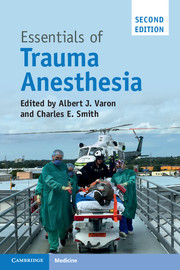Book contents
- Essentials of Trauma Anesthesia
- Essentials of Trauma Anesthesia
- Copyright page
- Epigraph
- Contents
- Contributors
- Preface
- Abbreviations
- Section 1 Core Principles in Trauma Anesthesia
- Section 2 Anesthetic Considerations for Trauma
- Section 3 Anesthetic Management in Special Trauma Populations
- Index
- References
Section 2 - Anesthetic Considerations for Trauma
Published online by Cambridge University Press: 30 October 2017
- Essentials of Trauma Anesthesia
- Essentials of Trauma Anesthesia
- Copyright page
- Epigraph
- Contents
- Contributors
- Preface
- Abbreviations
- Section 1 Core Principles in Trauma Anesthesia
- Section 2 Anesthetic Considerations for Trauma
- Section 3 Anesthetic Management in Special Trauma Populations
- Index
- References
- Type
- Chapter
- Information
- Essentials of Trauma Anesthesia , pp. 173 - 260Publisher: Cambridge University PressPrint publication year: 2017



